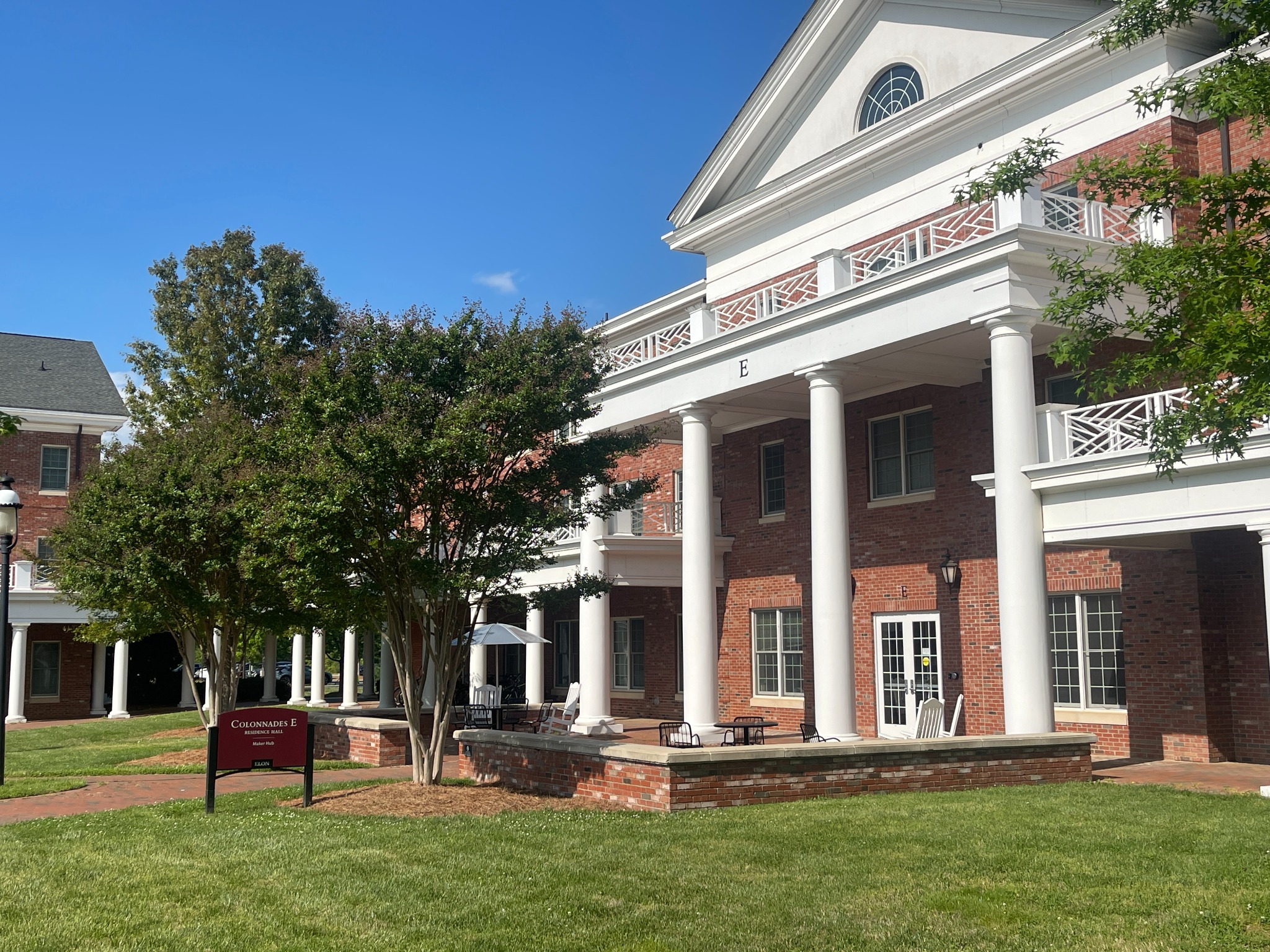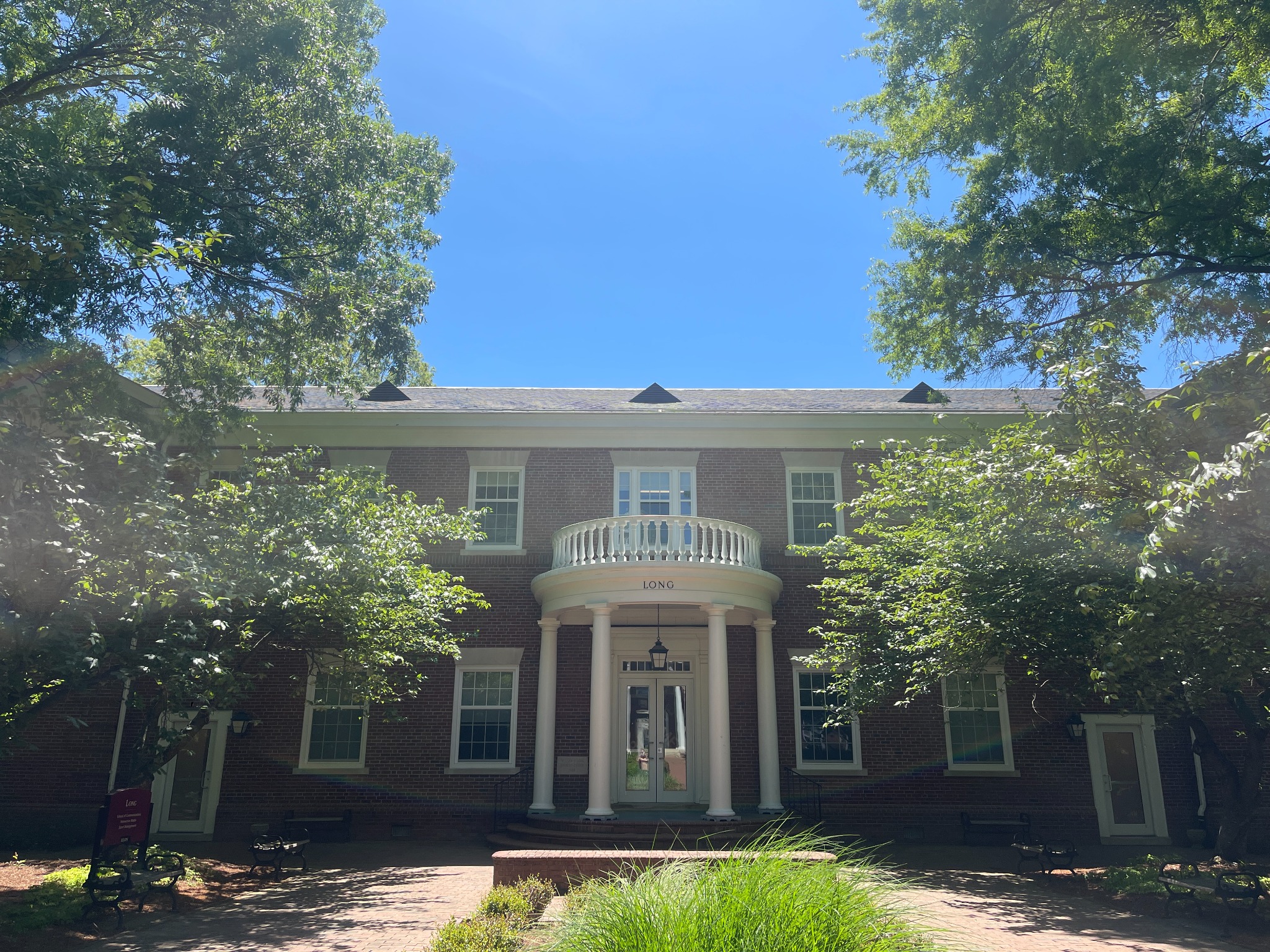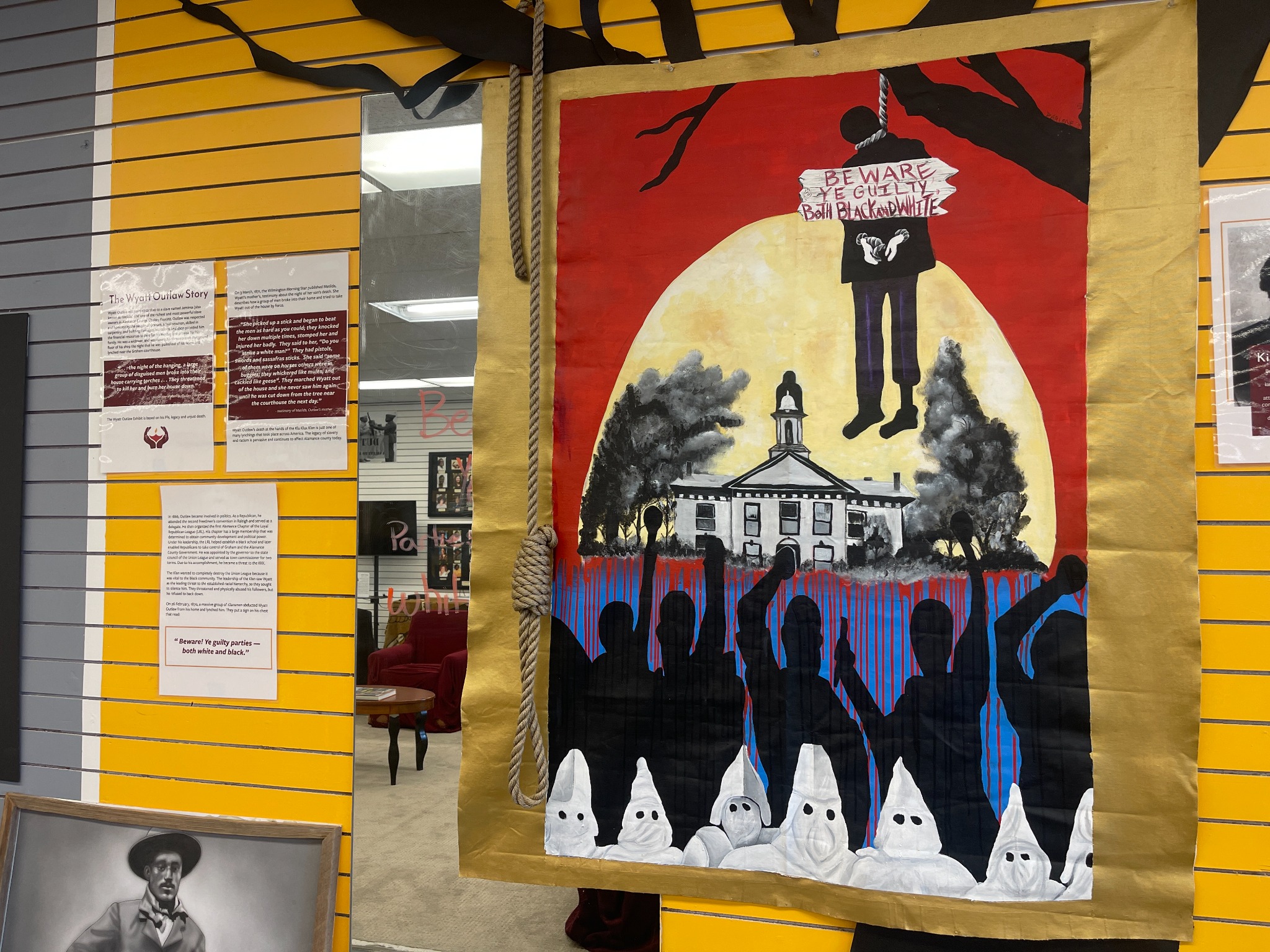Elon University confronts its dark past to create a brighter future
Former chair of Elon’s Board of Trustees and member for 40 years, Noel Allen bends down as his son places the red and gold ribbon holding the Elon Medallion around Allen’s neck on April 19 in the Great Hall inside Global Commons.
In addition to the medallion, the highest honor awarded by the University, Elon plans to honor Allen by renaming Colonnades E to Noel Allen Hall. A sign displaying the new name will be installed this summer, four years after removing the resident hall’s previous name, William Harper Hall.
The board of trustees voted to remove former president William Harper’s name on July 8, 2020, following a Change.org student petition signed by 5,127 individuals after Harper was accused of white supremacist ideologies and a connection to the lynching of a Black man.

Two years prior, in Aug. 2018, President Book announced the launch of the Commemoration Committee, now the Committee on Elon History and Memory, to explore “questions related to historical memory and collective identity at Elon University,” according to the committee's website.
As the current Committee on Elon History and Memory, led by Professor of Art History Dr. Evan Gatti, wraps up its work this academic year, they reflect on the Fall 2020 report created by the first installation of the committee and facilitate ways that Elon remembers and tells the forgotten stories of its past.
Gatti understands that many people would rather not explore the hard parts of Elon and Alamance County’s history. However, she believes talking about the dark parts of history is necessary.
"I'm committed to hard histories," Gatti said. "I know that to really know something, we have to know the things that we're proud of, and we have to know the things that we're ashamed of."
The Fall 2020 Report highlights 10 episodes of anti-Black racism and unheralded Black achievements in Elon’s past that have been only partially told or erased. The second installation of the Committee on Elon History and Memory, seated in 2021, shepherds the Fall 2020 report’s recommendations within the community.
Among these forgotten stories is the 1980 homecoming court.
Elon's First Black Homecoming Queen
As the crown was placed on the head of Elon University’s 1980 Homecoming Queen, Mary Carroll-Robertson, the crowd was not celebrating with cheers of encouragement and praise for their peer, but rather, they were booing.
Carroll-Robertson's crowning was unprecedented as Elon had never crowned a Black Homecoming Queen.
In a 2004 interview with L’Taynya Richmond in “Elon’s Black History,” Carroll-Robertson remembers looking through the 1980 yearbook and not finding the annual homecoming spread that would have featured her inaugural corrination.
“It was as if I didn’t even exist on campus,” Carroll-Roberston told Richmond.
The June 1980 edition of Jet Magazine reported that nearly 40 Black Elon Students burnt their yearbooks in protest of this omission. An omission that, according to the director of public information in 1980, Tim McDowell, was not intentional but resulted from photographs not being submitted on time.
Historian and Assistant Professor of History Amanda Kleintop, who works closely with the archives, often takes her students there so they can see this act of erasure in Elon’s history for themselves.
Kleintop shows students papers from the same time as homecoming, which include photos of Carroll-Roberston, whereas the yearbook does not.
“I will show them newspapers from right after homecoming, which was months before the yearbook was in and so we'll be like, ‘Well, there are pictures here,’” Kleintop said.
Kleintop said this story resonates with many of her women-identifying students because it is easy to see yourself in Carroll-Roberston’s story—this high-achieving female student who was extensively involved in campus life.
However, Elon’s relationship with episodes of anti-Black racism dates back over half a century before Caroll-Robertson was crowned.
William A. Harper
Harper is known widely in the Elon community as the president who rebuilt Elon after the fire of 1923. However, darker spots lay in the ashes of the university’s history under his presidency.
In 1910, Harper published an editorial in the Christian Sun titled “White Supremacy in Danger,” encouraging white parents to send their children to Elon College. He wrote, “The history of the world shows that education is essential to race leadership, and the negroes are willing to sacrifice for it more than are our whites.”
An editorial article written by William Harper in the Christian Sun in 1910 titled "White Supremacy Endangered" displays Harper's anti-Black stance.
Gatti believes that as an institution and a community, we must accept this complicated history and strive to be a different institution moving forward with other values.
“We have to own that was part of how we saw ourselves thriving,” Gatti said. “Then we have to say, ‘That is not who we want to be.’ We cannot say that’s not who we are. You don't say who you are. You show who you are.”
A decade after the Christian Sun editorial was published, Harper was the president of Elon and played a role in the arrest and call for an expedited trial of a Black man named John Jeffress (or Jeffries), who was visiting from another town. Historians and the committee do not know the correct spelling of his last name, so both spellings can be found when accessing documents related to this history.
Soil collected by the Alamance County Remembrance Coalition from the sites of John Jeffress' murder sits on display in the African-American Cultural Arts and History Center. Video By Audrey Geib
As detailed in the Fall 2020 Report, Harper led a posse of 25 people to arrest Jeffress after he was accused of sexually assaulting a minor. Gatti said that when exploring the Harper and Jeffress story, it is essential to know and understand that throughout this time, it was common for Black men to be accused of sexual crimes against white individuals. Due to his murder, Jeffress was never given a fair trial, so it is impossible to know if this accusation was based on truth or fabricated.
However, embedded in the complex history of Elon, other building names on campus have connections to racial injustice.

William S. Long
William Long was Elon’s first president who played a significant role in the foundation of Elon College in 1889. According to Elon's History and Previous Presidents page, he served as a professor and president until he resigned in 1894.
His connection to racial violence and white supremacy is not as evident as that of Harper’s. To understand the complexities of Long’s connection to racial inequity, you must know the story of the first black county commission of Grahm, Wyatt Outlaw.
Jacob A. Long and Wyatt Outlaw
Long and his brothers grew up in a prominent slaveholding family in Alamance County. In his adulthood, he lobbied for his peers to invest in education and was, therefore, the clear choice when choosing the first president of Elon College.
His younger brother, Jacob Long, played a darker role in this history.
As detailed in the Fall 2020 Report, Jacob Long formed Alamance County’s manifestation of the Ku Klux Klan, the “Constitutional Guard,” in 1868 and presided over the installation of the Confederate statue that still stands outside the Graham County courthouse today.
Just mere yards away from the location of the lynching of Outlaw.
During the reconstruction, Alamance County contained significant cases of anti-Black violence. Embedded in that history lay a story of unparalleled Black achievement with a tragic ending.
Outlaw was the first Black town commissioner, a town constable, a Union League organizer, and a small business owner. In his role as president of the Alamance County Union League of America, he stood against the KKK’s presence in Graham and advocated for a school for Black students.
On the night of Feb. 26, 1870, Outlaw was taken from his home by a group of 60 hooded Klansmen to the Graham County Court House, where he was hung. Around his neck lay a warning for anybody who wanted to take a stand against the KKK in Alamance, “Beware! Ye guilty parties – both white and black.”
The Fall 2020 report states that in 1871, Jacob Long perjured himself by denying his involvement in Outlaw’s death. At the time of the murder, Jacob Long claims to have been asleep in his law office downtown when the group of assailants woke him up to have “waked up [his] brother,” William Long.

'Not That Long'
As detailed in the Fall 2020 Report, Long’s story lacks a “smoking gun” or clear record of anti-Black racism. But in 1930, Jacob Long’s son Ralph said that among the Long children’s interests, there was “not a semblance of a Black sheep in the half-dozen.”
Gatti believes that the issue with the Long building and whether the name should be removed is not as easy as saying that the building should be un-named because Long is not connected to such a blatant act of racial violence as Harper or Jacob Long.
“We don’t have something we can say, ‘Here’s the bad act that led to the thing,’” Gatti said. “We have, ‘Here is a reflection of White Supremacist values. Here is a way that the cultural context valued some lives more than others, and in this case, it valued the voice and position of William S. Long and not Wyatt Outlaw. Both of whom were really important figures in their community.’”
Due to this complexity, Gatti believes a renaming of the Long building is not necessarily the solution. Still, neither is writing off the conversation because it was ‘not that Long.’
Instead, she said that fostering community conversations around the implications of Long being held to a higher position than Wyatt Outlaw should be explored.
An interactive map displays notable locations from the stories of Elon's past along with photos of each. Design By Audrey Geib
Creating a Better Elon
Following the un-naming of William Harper Hall, Book announced five action steps for diversity, equity and inclusion. Among the steps was creating a requirement for every Elon student, regardless of their major, to “take courses that drive deeper understanding of diversity, equity, and inclusion.”
Assistant Director for Diversity, Equity and Inclusion in the Elon Core Curriculum, Dr. Jessica Carew, oversees the newly instituted Advancing Equity Requirement and the standing committee that vets the courses that fulfill this credit.
As this academic year ends, so does the inaugural year of the AER. Carew is excited about how the courses taught this year went and the future of the AER in years to come.
“I'm really pleased with how things have been going,” Carew said. “The courses have been doing really well in terms of enrollments and also ensuring that the students have the opportunity to take them.”
Along with the creation of the AER, the additional learning goal of equitable thinking was added to the mission of the Elon Core Curriculum. Carew said that one of the goals of the AER is to provide students with the tools needed to recognize systemic injustices and understand ways that they could alleviate those inequities.
The work to create a better Elon is far from over. Still, community members are working to create a brighter institution that recognizes its brutal history while celebrating its fruitful future, including renaming Colonnades E to Allen Hall.
Vice President for Inclusive Excellence Randy Williams believes that people like Allen facilitate positive change in the community by ensuring that students' various identities are included when thinking about Elon as a whole.
“He's been one of the architects of this work,” Williams said.
In a recent Board of Trustees meeting, Williams said that Allen asked how a specific data set affects various student identities.
“We were looking at some data around retention, and we were scheduled to do some disaggregation with a presentation. But, before we even got there, he was inquiring, ‘Well, how does this look for students of color, for example?’ So to me, that is an example of how he cares about this institution and recognizes that there are different identities in this community as well.”
Senior Lecturer in Human Service Studies Sandra Reid was on the inaugural committee of Elon History and Memory. Reid said that she believes it is essential for Elon students to know and engage with this history because it is woven into the foundation of the campus they call home.
“If we were to ever be able to come together completely in a community, we would need to reconcile these things that have gone on,” Reid said. “I think it's important for Elon students to know about it because they walk this campus every day. I think they should know and be engaged in the history.”
Post a comment